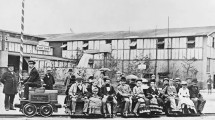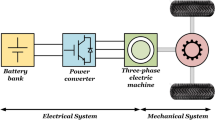Abstract
Proper traffic simulation of electric vehicles, which draw energy from overhead wires, requires adequate modeling of traction infrastructure. Such vehicles include trains, trams or trolleybuses. Since the requested power demands depend on a traffic situation, the overhead wire DC electrical circuit is associated with a non-linear power flow problem. Although the Newton-Raphson method is well-known and widely accepted for seeking its solution, the existence of such a solution is not guaranteed. Particularly in situations where the vehicle power demands are too high (during acceleration), the solution of the studied problem may not exist. To deal with such cases, we introduce a numerical method which seeks maximal suppliable power demands for which the solution exists. This corresponds to introducing a scaling parameter to reduce the demanded power. The interpretation of the scaling parameter is the amount of energy which is absent in the system, and which needs to be provided by external sources such as on-board batteries. We propose an efficient two-stage algorithm to find the optimal scaling parameter and the resulting potentials in the overhead wire network. We perform a comparison with a naive approach and present a real-world simulation in the part of the Pilsen city in the Czech Republic. These simulations are performed in the traffic micro-simulator SUMO, a popular open-source traffic simulation platform.
Similar content being viewed by others
References
E. L. Allgower, K. Georg: Numerical Continuation Methods: An Introduction. Springer Series in Computational Mathematics 13. Springer, Berlin, 1990.
H.-D. Chiang, T. Wang: Novel homotopy theory for nonlinear networks and systems and its applications to electrical grids. IEEE Trans. Control Netw. Syst. 5 (2018), 1051–1060.
A. L. Dontchev, R. T. Rockafellar: Implicit Functions and Solution Mappings: A View from Variational Analysis. Springer Monographs in Mathematics. Springer, New York, 2009.
F. Dörfler, J. W. Simpson-Porco, F. Bullo: Electrical networks and algebraic graph theory: Models, properties, and applications. Proc. IEEE 106 (2018), 977–1005.
A. Garcés: Uniqueness of the power flow solutions in low voltage direct current grids. Electric Power Systems Research 151 (2017), 149–153.
A. Garcés: On the convergence of Newton’s method in power flow studies for DC microgrids. IEEE Trans. Power Syst. 33 (2018), 5770–5777.
A. Garcés, O.-D. Montoya: A potential function for the power flow in DC microgrids: An analysis of the uniqueness and existence of the solution and convergence of the algorithms. J. Control Automation Electr. Syst. 30 (2019), 794–801.
C.-W. Ho, A. Ruehli, P. Brennan: The modified nodal approach to network analysis. IEEE Trans. Circuits Syst. 22 (1975), 504–509.
Institute of Transportation Systems at the German Aerospace Center: Eclipse SUMO — Simulation of Urban MObility. Available at https://www.eclipse.org/sumo/ (2021).
C. Jayarathna, P. Binduhewa, J. Ekanayake, J. Wu: Load flow analysis of low voltage DC networks with photovoltaic. 2014 9th International Conference on Industrial and Information Systems (ICIIS). IEEE, Piscataway, 2014, pp. 536–541.
B.-Y. Ku, J.-S. Liu: Solution of DC power flow for nongrounded traction systems using chain-rule reduction of ladder circuit Jacobian matrices. ASME/IEEE Joint Conference on Rail. IEEE, Piscataway, 2002, pp. 123–130.
P. A. Lopez, M. Behrisch, L. Bieker-Walz, J. Erdmann, Y.-P. Flötteröd, R. Hilbrich, L. Lücken, J. Rummel, P. Wagner, E. Wiessner: Microscopic traffic simulation using SUMO. 21st IEEE International Conference on Intelligent Transportation Systems. IEEE, Piscataway, 2018, pp. 2575–2582.
O. D. Montoya, L. F. Grisales-Noreña, D. González-Montoya, C. A. Ramos-Paja, A. Garcés: Linear power flow formulation for low-voltage DC power grids. Electric Power Systems Research 163 (2018), 375–381.
M. Salih, D. Baumeister, M. Wazifehdust, P. Steinbusch, M. Zdrallek, S. Mour, P. Deskovic, T. Küll, C. Troullier: Impact assessment of integrating novel battery-trolleybuses, PV units and EV charging stations in a DC trolleybus network. 2nd E-Mobility Power System Integration Symposium. KTH-Royal Institute of Technology, Stockholm, 2018, pp. 1–6.
J. Sevcik, J.Prikryl: A vehicle device tailored for hybrid trolleybuses and overhead wires implementation in SUMO. SUMO User Conference 2019 (M. Weber et al., eds.). EPiC Series in Computing. EasyChair, 2019, pp. 145–157.
S. Taheri, V. Kekatos: Power flow solvers for direct current networks. IEEE Trans. Smart Grid 11 (2020), 634–643.
C. W. Tan, D. W. H. Cai, X. Lou: DC optimal power flow: Uniqueness and algorithms. 2012 IEEE Third International Conference on Smart Grid Communications. IEEE, Piscataway, 2012, pp. 641–646.
E. Zhou, A. Nasle: Simulation of DC power distribution systems. Proceedings of Industrial and Commercial Power Systems Conference. IEEE, Piscataway, 1994, pp. 191–195.
Author information
Authors and Affiliations
Corresponding author
Additional information
This work was supported by the Ministry of Education, Youth and Sports of the Czech Republic under the project OP VVV Electrical Engineering Technologies with High-Level of Embedded Intelligence, CZ.02.1.01/0.0/0.0/18_069/0009855, project OP VVV Research Center for Informatics, CZ.02.1.01/0.0/0.0/16_019/0000765, and by UWB Student Grant Project no. SGS-2021-021.
Rights and permissions
About this article
Cite this article
Ševčík, J., Adam, L., Přikryl, J. et al. Solvability of the power flow problem in DC overhead wire circuit modeling. Appl Math 66, 837–855 (2021). https://doi.org/10.21136/AM.2021.0280-20
Received:
Published:
Issue Date:
DOI: https://doi.org/10.21136/AM.2021.0280-20




